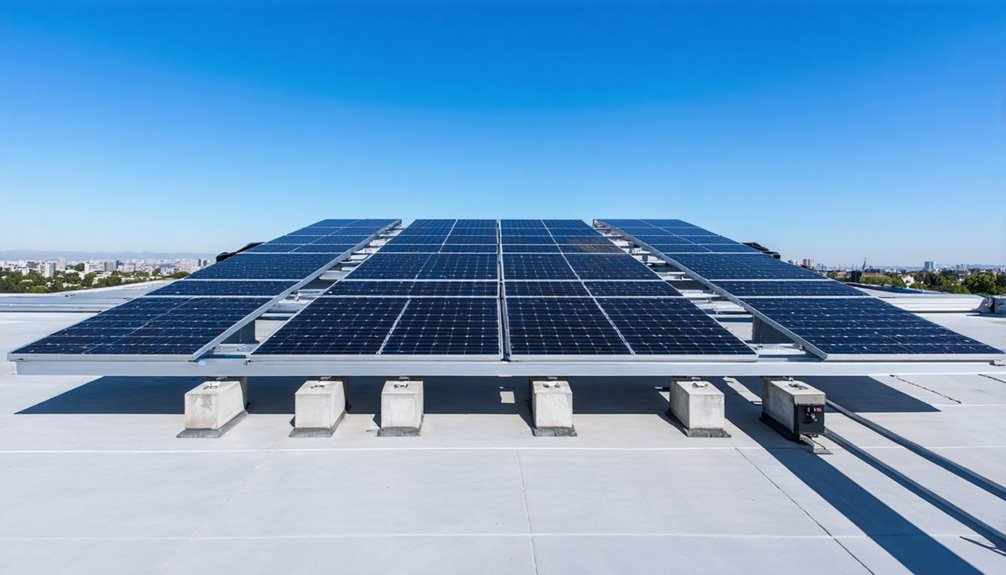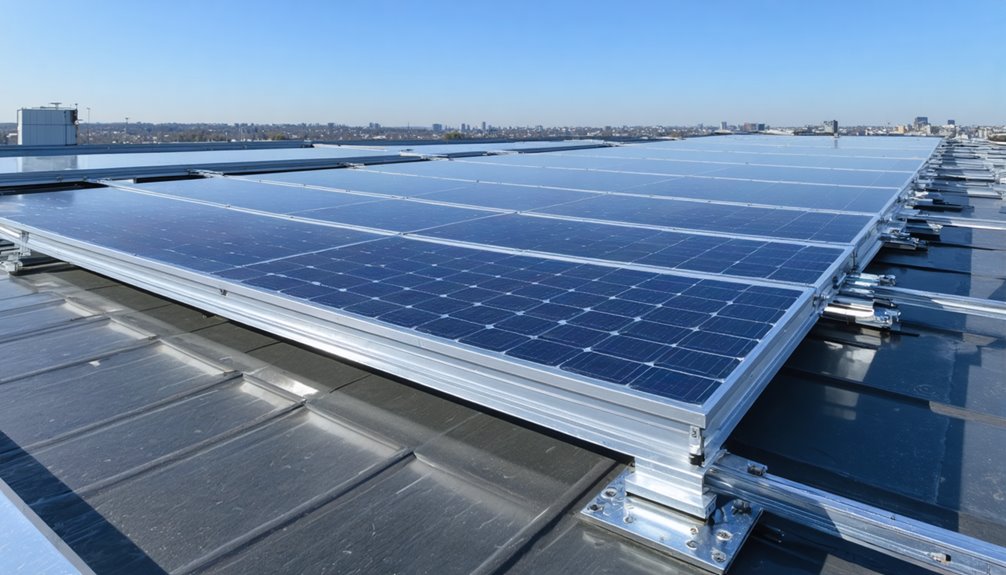To mount solar panels on flat roofs without drilling, use non-penetrating systems like ballasted mounts. These systems secure with concrete weights, maintaining your roof’s integrity and warranty while reducing leak risks. Confirm your roof supports the weight, and adjust panels for ideal sunlight capture. Ballasted mounts also offer easy maintenance access, so you’ll save on labor and potential repairs. Exploring further provides insights into installation considerations, maintenance practices, and industry trends to optimize your solar experience.
Benefits of Installing Non-Penetrating Solar Panels
Installing non-penetrating solar panels on a flat roof offers significant advantages, primarily because these systems use ballasted mounts that secure the panels with weights instead of traditional drilling methods, which substantially reduces the risk of roof leaks and damage. With this installation process, you preserve your roofing integrity and avoid voided warranties caused by penetrations. By using non-penetrating mounts, you can adapt the solar panel system to accommodate unique roof shapes, enhancing flexibility while maintaining stability against high winds. This setup allows for ideal angle positioning, maximizing efficiency. The cost savings appear not only from reduced labor and minimized risk of future repairs but also from maintaining maintenance access without invasive modifications, ensuring a thorough approach to long-term solar energy adoption. This approach aligns with the concept of a ballast mount, which uses weights rather than penetrations to secure panels.
Ballasted Mounting Systems for Flat Roofs
Although flat roofs present certain challenges for solar panel installation, ballasted mounting systems offer an effective solution by using heavy concrete blocks to firmly secure the panels without the need for roof penetrations, thereby minimizing the risk of leaks. These systems are specifically designed to keep solar panels stable with non-penetrating mounts, ensuring the roof surface remains unscathed. By using rubber pads or mats, potential abrasion is minimized, which is critical for maintaining roof integrity. Ballasted mounts can be adjusted to support solar panels at ideal angles, generally between 20-50 degrees, enhancing energy collection. Additionally, the absence of drilling leads to shorter installation times and reduced installation costs. These systems seamlessly adapt to various roof shapes, facilitating energy scalability based on specific building needs. Understanding wind uplift performance helps determine appropriate ballast and mounting approach wind uplift for different roof designs.
Installation Considerations and Best Practices
Ballasted mounting systems offer a practical solution for securing solar panels on flat roofs, but you’ll need to account for several important installation considerations to guarantee peak performance and structural integrity. Additionally, verify the structure can withstand wind and snow loads when designing ballast layouts to ensure stability in extreme weather. Begin with evaluating the roof’s weight-bearing capacity to handle the combined load of solar panels and ballast, fundamental in non-penetrating mounting systems. Determine ideal tilt angles, usually between 10° to 30°, for maximizing sunlight exposure and solar energy output. Carefully calculate row spacing to prevent shading, especially during winter months. Ballasted installations benefit from easy maintenance access, but planning should guarantee clear pathways. Flat roof installation demands precision in these areas to guarantee efficient solar energy production and long-term viability of the system without compromising roof integrity.
Maintenance and Performance Optimization

Maintaining peak performance of solar panels on flat roofs requires careful attention to several key maintenance practices that protect and enhance energy output throughout the year. Regular maintenance involves clearing debris accumulation to guarantee unimpeded sunlight exposure, which notably affects the panels’ efficiency. Flat surfaces facilitate this process, enhancing consistent superior energy output. Scheduled inspections are essential to detect wear, damage, or shading from nearby structures, guaranteeing effective operation. Integrating energy production data enables you to monitor performance, trigger timely maintenance, and improve long-term efficiency. Additionally, leveraging tilting mounts allows adjustments to the solar panel angle, improving solar capture and adapting to seasonal sunlight variations, ultimately boosting energy production. These strategies collectively maintain the high efficiency of flat roof solar panels. For many flat-roof installs, choosing a ballasted mounting system helps resist uplift without drilling.
Industry Trends and Future Innovations
As the solar industry evolves, a clear trend emerges towards non-penetrating solar panel systems, driven by the need for flexible installation methods that safeguard roof integrity while maximizing energy production. Flat roofs offer the ideal surface for mounting solar technologies, incorporating weight-based ballast systems that secure solar panel installations without impacting waterproofing or structural support. These industry trends reflect a marked increase in non-invasive setups, showcasing innovations in materials like aluminum and stainless steel that enhance system durability and efficiency. Collaborative efforts aim to establish standards and certifications for these methods, ensuring reliable performance across various applications. By focusing on non-penetrating systems, the solar industry emphasizes energy generation and roof integrity, aligning future innovations with growing market demand. Non-penetrating systems like ballast-based racks and adhesive-bonded mounts help protect waterproofing while enabling scalable installation, a trend supported by industry efforts to standardize certifications ballasted racking.
Conclusion
Non-penetrating solar panel installations on flat roofs offer significant advantages including preserved roof integrity, simplified installation through ballasted mounting systems, and reduced structural impact. Success depends on proper attention to weight distribution, wind resistance calculations, and precise alignment to ensure optimal performance and system longevity. Regular maintenance protocols, encompassing routine inspections and cleaning schedules, are essential for maximizing energy output over the system’s operational lifetime. As the renewable energy sector continues advancing with innovative materials and improved designs, the industry is witnessing enhanced efficiency and greater adaptability in mounting solutions. Solocity Global serves as a trusted exporter of solar panel mounting systems, providing high-quality, standards-compliant mounting solutions to clients across international markets. Their comprehensive product range supports the growing demand for reliable and low-impact renewable energy installations in urban environments worldwide.


